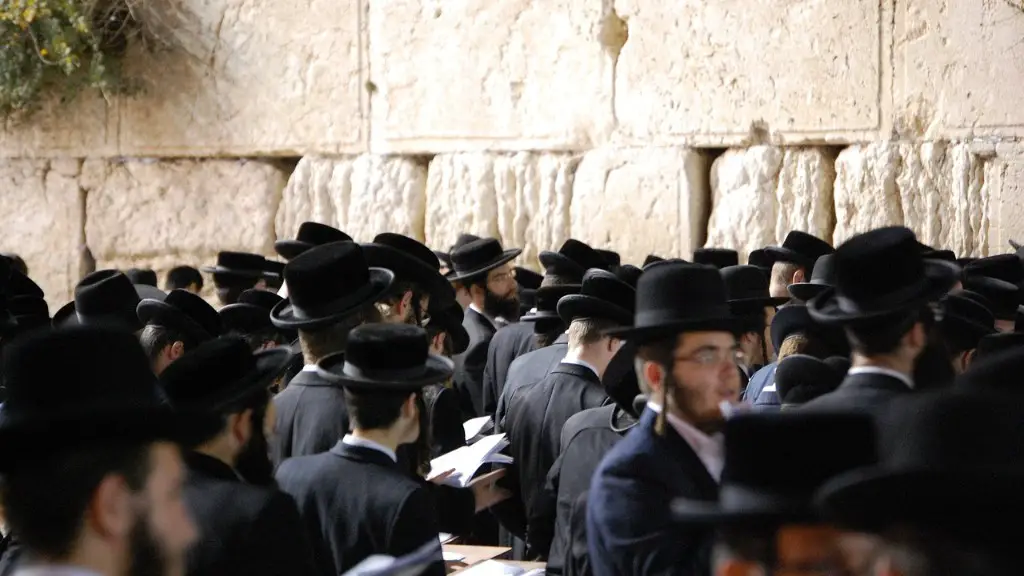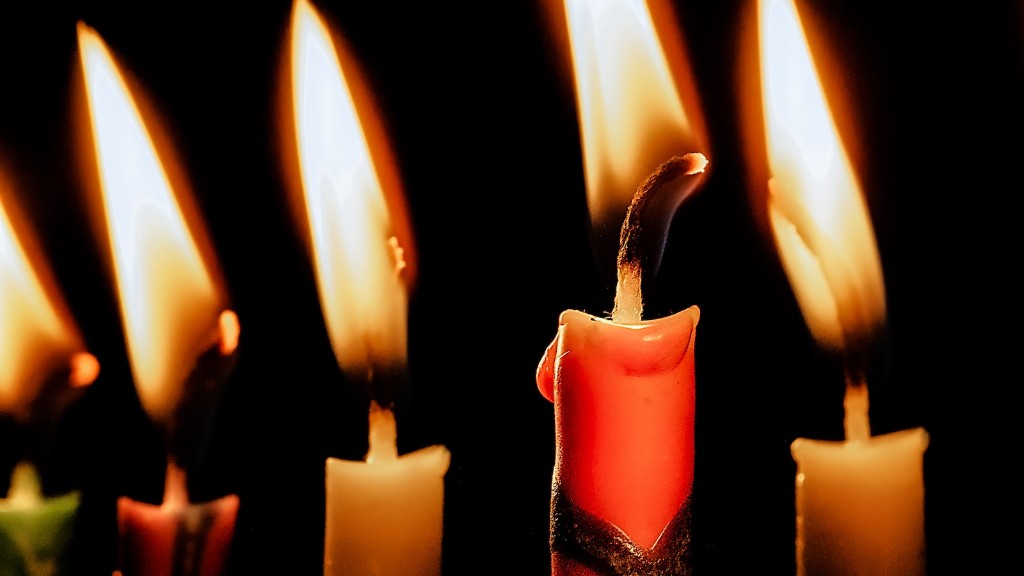Main Topic: Where Did Judaism Originate?
The origins of Judaism date back well over three thousand years, making it oldest of the world’s four largest religions. It is believed that Judaism is a tradition passed down from father to son, originating with the historical figure of Abraham. Although the religion has seen much change and adaptation since its inception, many of the core values of the faith remain the same. Here, we will explore the history of Judaism, from its ancient roots to the present day.
Judaism is said to have first developed as a tribal religion somewhere in the Middle East. The Bible recounts how Abraham and his descendants settled in ancient Israel, bringing with them their faith and beliefs. Over time, Jewish culture and customs began to emerge, such as rules around dietary restrictions, circumcision, and the concept of the Jews as God’s chosen people. By the time of Moses, Judaism had become a fully-formed religion.
In 639 BCE, King Nebuchadnezzar of Babylon destroyed the First Temple in Jerusalem, sending shockwaves through the Jewish community. Over the next few centuries, Jews all over the world faced epic struggles and hardships. This, coupled with the new ideas being introduced by rulers such as Alexander the Great, helped cement the practices and beliefs of Judaism. By the time of the destruction of the Second Temple in 70 CE, the religion had grown and spread far and wide.
The destruction of the Second Temple saw the beginnings of the modern era of Judaism, as the practice of Judaism shifted from one that was heavily centered around the Temple to one based more on religious texts and study. During this tumultuous time, the Talmud was compiled and the role of rabbis began to emerge. This period also saw the rise of multiple other religions in the area, all competing for their place in history, including Christianity and Islam.
Centuries later, a new wave of Jewish religious thought emerged with the writings of philosopher Moses Maimonides. This period of religious exploration saw many Jews expand their faith, incorporating elements of science and philosophy into their interpretation of ancient texts. By the nineteenth century, reform Judaism had emerged and was gaining traction throughout Europe and the Americas.
Today, Judaism is still practiced in various ways all over the world. There is a great diversity of beliefs and customs practiced, from Orthodox rabbinical Judaism to renewal Judaism and more. Nevertheless, many core elements of the religion remain the same and it continues to be a strong force in the world today.
Modern Orthodox Judaism
Modern Orthodox Judaism is arguably the most traditional and conservative of the three main branches of Orthodox Judaism. It seeks to combine modern life with traditional religious practice and beliefs. Adherents generally strive to adhere to the commands laid out in the Torah and other Jewish laws, while also using modern technologies and knowledge. Modern Orthodoxy is generally observed in synagogues and communities, with the men and women usually sitting together and the men always leading or officiating the services.
Modern Orthodox Jews tend to be open to the idea of intellectual development, relying upon the latest textual and scientific research. They also focus strongly on educational requirements and the need for ongoing learning within the community. While generally quite liberal and open, Modern Orthodox Jews do maintain certain dress codes, such as head coverings for married women.
In terms of religious observance, Modern Orthodox Jews seek to live as fully observant Jews, adhering to all relevant Jewish laws. This includes things such as kashrus (keeping Kosher), Shabbat observance, separation between men and women, and the regular study of Torah. However, there is some flexibility here, as many Modern Orthodox Jews believe they can pick and choose which laws they feel comfortable following and adapting them to fit a modern lifestyle. This is often referred to as “Centrist Orthodoxy”.
Modern Orthodoxy has seen great growth in recent years, with a number of new synagogues, schools, and groups being established throughout the world. This mix of traditional religious practice and modern life, along with its focus on education, has allowed the Modern Orthodox movement to attract a growing number of adherents.
Conservative Judaism
Conservative Judaism is the second main branch of Orthodox Judaism. It emerged in the late 19th century as an effort to provide a more modern interpretation of Judaism. Like Modern Orthodoxy, Conservative Judaism emphasizes the importance of being an observant, Torah-abiding Jew. However, it places less emphasis on strict adherence to Jewish law and more emphasis on adapting to the modern world.
Conservative Judaism is generally less strict and traditional than Modern Orthodoxy. It allows for greater flexibility in terms of religious beliefs and practices. Conservative Jews still observe the major Jewish laws, such as keeping kosher and observing Shabbat, but with more leniency. They also focus more on incorporating elements of modern culture and thought into their religious practices.
In terms of religious observance, Conservative Judaism seeks to present a balanced approach to Torah study. This involves combining traditional textual study with modern thought and scholarship. They also generally favor gender equality in the synagogue, allowing both men and women to lead services and read from the Torah. Lastly, Conservative Jews generally favor a more inclusive and tolerant attitude towards non-Jews.
Today, Conservative Judaism is the most popular of the three main branches of Orthodox Judaism. There are many prominent Conservative synagogues and schools throughout the world, allowing Conservative Jews to practice their faith in a modern, flexible way. It remains a popular choice for those seeking to balance their faith and modern life.
Reform Judaism
Reform Judaism is the third main branch of Orthodox Judaism. It emerged in the early nineteenth century in Germany as a more modern interpretation of the religion. Unlike the more conservative movements, Reform Judaism focuses more on developing a sense of ethical social responsibility and less on strict adherence to Jewish law. Reform Jews generally deemphasize traditional religious practice in favor of an approach that embraces modern values and ideas.
In terms of religious observance, Reform Judaism is much more flexible than Conservative or Modern Orthodox Judaism. Reform Jews generally have an informal approach to religious practice and are generally more open to intermarriage, interfaith dialogue, and gender equality. They also often focus less on traditional Jewish laws and more on social responsibility and ethical issues.
Reform Judaism is the least traditional and most progressive of the three main branches of Orthodox Judaism. It has gained traction amongst many modern Jews who want to emphasize their religious identity without compromising their commitment to modern values and ethics. It is widely seen as the most moderate and liberal of the three major branches of Orthodox Judaism.
Reconstructionist Judaism
Reconstructionist Judaism is the fourth main branch of Orthodox Judaism. It emerged in the early twentieth century as a more progressive interpretation of traditional Jewish law and practice. It is a modernist, non-theistic branch of Judaism that seeks to apply traditional Jewish values to the contemporary world. While Reconstructionist Jews still adhere to traditional Jewish laws, they tend to emphasize the ethical and moral rather than the ritualistic aspects of Judaism.
Reconstructionist Jews generally favor a more egalitarian approach to religious observance. They are less strict about Jewish law and generally emphasize creativity and experimentation in religious practice. They are more open to intermarriage and interfaith dialogue, and generally focus more on the ethical and moral aspects of Judaism than on ritualistic observance.
Today, Reconstructionist Judaism is growing in popularity, particularly amongst those who are seeking a more progressive approach to Judaism. It offers a more liberal interpretation of Jewish law and spiritual practice and many find its focus on morality, ethical behavior, and social justice to be highly attractive. It remains a popular choice amongst many Jews who are looking for a modern, non-theistic interpretation of traditional Jewish values.
Humanistic Judaism
Humanistic Judaism is the fifth main branch of Orthodox Judaism. It emerged in the mid-twentieth century as an alternative to more traditional forms of Judaism. Humanistic Judaism is a religious and cultural movement that focuses on the celebration of Jewish life and identity without the religious beliefs commonly associated with traditional Judaism. It is non-theistic, and sees Judaism as a culture and an ethical framework for living, rather than as a religion.
Humanistic Jews practice their Judaism with the same dedication and commitment as their more traditional counterparts. However, their practices do not involve belief in a supernatural deity or following traditional rituals and laws. Instead, they focus on celebrating Jewish holidays, culture, and history in a secular way. They also emphasize ethical behavior and social justice, advocating for greater equality and inclusivity.
Today, Humanistic Judaism is growing in popularity, particularly amongst those seeking a more secular, humanistic interpretation of Judaism. It is attractive to those who want to express their Jewish identity without adhering to traditional religious practices and beliefs. It remains a popular choice amongst modern Jews looking for an alternative form of Judaism.
Conclusion
Judaism is an ancient and profoundly meaningful religion with a variety of branches and interpretations. From its ancient roots to present day, Judaism has seen much change and adaptation, while maintaining many of its core values. The five main branches of Orthodox Judaism provide a range of options for those looking to observe the religion in a modern and meaningful way. No matter which branch of Judaism one chooses, all serve to deepen the understanding and appreciation of this fascinating faith.




